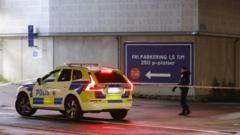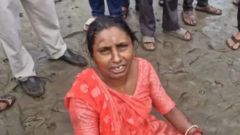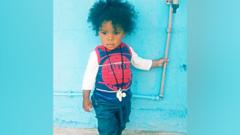Increasing crime rates in South African townships are driving parents to enroll their children in former white-only schools, highlighting enduring inequalities in education post-apartheid.
Cape Town Parents Opt for Former White-Only Schools Amid Safety Concerns

Cape Town Parents Opt for Former White-Only Schools Amid Safety Concerns
Rising crime and violence in Cape Town's townships lead families to seek safer schooling options far from home.
Article Text:
Fears surrounding crime and gang activity in the townships on the outskirts of Cape Town are forcing parents to make heart-wrenching choices regarding their children's education, as many seek safer alternatives at former white-only schools. Concerns over frequent violence, such as armed intrusions and threats to teachers, have led families like the Mbasanas to consider long commutes to schools that promise better safety.
Sibahle Mbasana, a mother of three, recounted the harrowing experiences her sons faced at their former school in Khayelitsha, Cape Town's largest township, where lax security often rendered them vulnerable to criminal activities. With the residual impact of apartheid's Bantu Education Act of 1953 still felt today, many township schools struggle with overcrowding, insufficient resources, and high crime rates, leaving parents like Mrs. Mbasana to feel their children would fare better elsewhere.
Determined to provide her children with a safer and more favorable educational environment, Mrs. Mbasana transferred her sons, Lifalethu, 12, and Anele, 11, along with their sister Buhle, 7, to a state school located 40 kilometers (25 miles) away in Simon's Town, a scenic area known for its navy presence. The decision came not without its challenges, including long and strenuous daily commutes.
"The children leave home at 4:30 AM, and even when they return in the evening, they're exhausted," Mrs. Mbasana explained. The family's struggles reflect a broader issue, as the safety concerns have become a significant deterrent for many parents whose children endure lengthy journeys for education that might otherwise be closer to home.
Despite the existence of dedicated staff at township schools who strive to improve educational outcomes, the prevailing threat of gangs demanding fees and engaging in violent behavior has jeopardized both student and teacher safety. Reports indicate that instructors at some schools face intimidation, further compounding the difficulties.
With many families trapped in townships due to financial constraints, the grim realities of the educational landscape are exacerbated by funding challenges in local schools. The Western Cape Education Department has acknowledged the need for increased security measures, but the recent cuts to teaching positions in these areas have raised red flags regarding their impact.
The journey for families like the Mbasanas is emblematic of the persistent inequalities that pervade South Africa’s education system. Despite the end of apartheid nearly three decades ago, access to quality education remains heavily dependent on various factors, including geographic location and socio-economic status. As mothers like Sibahle navigate these tough decisions, the disparity in educational resources continues to pose a serious challenge for achieving equity and safety for all students in the region.
Fears surrounding crime and gang activity in the townships on the outskirts of Cape Town are forcing parents to make heart-wrenching choices regarding their children's education, as many seek safer alternatives at former white-only schools. Concerns over frequent violence, such as armed intrusions and threats to teachers, have led families like the Mbasanas to consider long commutes to schools that promise better safety.
Sibahle Mbasana, a mother of three, recounted the harrowing experiences her sons faced at their former school in Khayelitsha, Cape Town's largest township, where lax security often rendered them vulnerable to criminal activities. With the residual impact of apartheid's Bantu Education Act of 1953 still felt today, many township schools struggle with overcrowding, insufficient resources, and high crime rates, leaving parents like Mrs. Mbasana to feel their children would fare better elsewhere.
Determined to provide her children with a safer and more favorable educational environment, Mrs. Mbasana transferred her sons, Lifalethu, 12, and Anele, 11, along with their sister Buhle, 7, to a state school located 40 kilometers (25 miles) away in Simon's Town, a scenic area known for its navy presence. The decision came not without its challenges, including long and strenuous daily commutes.
"The children leave home at 4:30 AM, and even when they return in the evening, they're exhausted," Mrs. Mbasana explained. The family's struggles reflect a broader issue, as the safety concerns have become a significant deterrent for many parents whose children endure lengthy journeys for education that might otherwise be closer to home.
Despite the existence of dedicated staff at township schools who strive to improve educational outcomes, the prevailing threat of gangs demanding fees and engaging in violent behavior has jeopardized both student and teacher safety. Reports indicate that instructors at some schools face intimidation, further compounding the difficulties.
With many families trapped in townships due to financial constraints, the grim realities of the educational landscape are exacerbated by funding challenges in local schools. The Western Cape Education Department has acknowledged the need for increased security measures, but the recent cuts to teaching positions in these areas have raised red flags regarding their impact.
The journey for families like the Mbasanas is emblematic of the persistent inequalities that pervade South Africa’s education system. Despite the end of apartheid nearly three decades ago, access to quality education remains heavily dependent on various factors, including geographic location and socio-economic status. As mothers like Sibahle navigate these tough decisions, the disparity in educational resources continues to pose a serious challenge for achieving equity and safety for all students in the region.





















